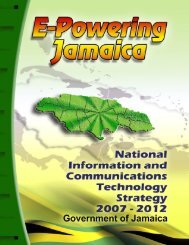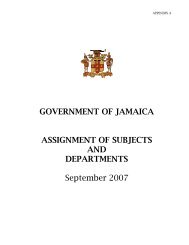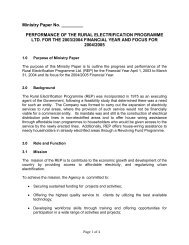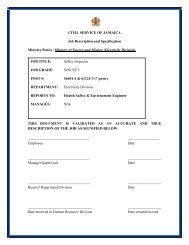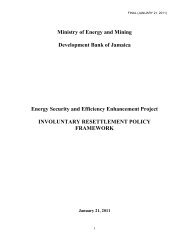Jamaica Biofuels Report - Ministry of Energy
Jamaica Biofuels Report - Ministry of Energy
Jamaica Biofuels Report - Ministry of Energy
You also want an ePaper? Increase the reach of your titles
YUMPU automatically turns print PDFs into web optimized ePapers that Google loves.
Sugar cane is naturally tolerant to salinity, using sodium in some metabolic functions whereother plants use potassium. This does not mean that excess sodium will not cause harm. Wheresoil sodium is higher than normal, varieties with higher tolerance to these salinity conditionsneed to be developed through the breeding program. Additionally, soils with high sodiumrequire greater care in the application <strong>of</strong> vinasse as fertilizer, due to reduced margin for errorbefore the plants are harmed.4. Work being undertaken by the Sugar Industry Research Institute (based on visit to trialplots May 20, 2010)The Sugar Industry Research Institute (SIRI) is doing a very good job in selecting new varietiesand using good agricultural practices showing, in the field, that it is possible to achieve higheryields than currently being realized. Without resort to revolutionary techniques, SIRI is showingthat significantly higher productivity is possible. However, there are limitations due to thelimited number <strong>of</strong> sites where trials are conducted and dependence on the current limitation <strong>of</strong>breeding stocks from a single source (Barbados). The selection <strong>of</strong> the breeding program workswith about 30 thousand seedlings/year, and considering the great variability <strong>of</strong> sugar canebreeding, it can be characterized as a relatively small program. However, it is well conducted.It is strongly recommended that this program be expanded to cover all existing conditions inthe island and through the introduction <strong>of</strong> breeding stock from other sources. The program canbe used to adapt and develop other agricultural practices and be a testimonial <strong>of</strong> how to growthe crop for local farmers. Based on this, SIRI can play an important role in extension services toachieve the improved production goals, because they have knowledge that can bedisseminated to the farmers.Among the different plots visited at the SIRI Experimental Station, two varieties shown greatpotential: BJ 75-04 and BJ 74-52. The plots were prepared with good soil to a depth <strong>of</strong>approximately 40 cm to ensure good root system development and vigorous aerial parts. Theplots received a fertilization program based on 250 kg/ha <strong>of</strong> 14-28-14 (N-P 2 O 5 -K 2 O) and 250kg/ha <strong>of</strong> 17-00-20 in ratoon crop. Overall the trial shows that these simple practices alone areadequate to increase the productivity <strong>of</strong> sugar cane in <strong>Jamaica</strong>, in the short term, byapproximately 50% in some areas.5 Options for <strong>Jamaica</strong>Since there is a need for biomass to produce energy as well as granular sugar, molasses andethanol, the sugar cane crop seems to be the most reliable crop to fulfill these combined goalsin <strong>Jamaica</strong>. Other crops (e.g., sweet sorghum) that could supplement sugar cane for one ormore <strong>of</strong> these products may be possible over time but not in the short term and not withoutexperimentation and slow introduction. Additionally, in <strong>Jamaica</strong> there is already a strongdemand for molasses by the rum industry. So in order to achieve the overall needs, it isnecessary to increase production both in area planted and in yields (total recoverablesugars/area). The total tonnage must be increased over a larger area and within current areas.15



